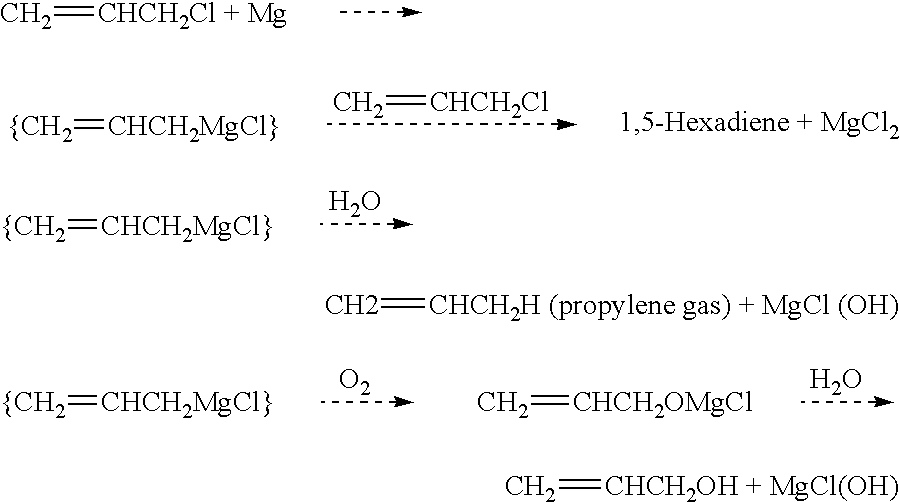Grignard preparation of unsaturated organic compounds
- Summary
- Abstract
- Description
- Claims
- Application Information
AI Technical Summary
Benefits of technology
Problems solved by technology
Method used
Image
Examples
example 1
Comparison Example Against the Prior Art Using Ether as the Only Solvent
The final molar ratio of ether to the allyl chloride was 16:1. Magnesium metal (1.82 grams, 0.08 mole) and anhydrous diethyl ether (33.6 grams, 0.47 mole) along with 3.07 grams, 0.08 mole) of n-octane were loaded into a 3-necked, 1 liter glass flask. At the beginning, a clear solution with magnesium metal was observed. The solution was then heated to ether reflux at about 32.degree. C. From a 1 liter addition funnel, a solution of allyl chloride (16.59 , 0.21 mole), diethyl ether (84.73 grams, 1.17 mole) was slowly added to the refluxing ethereal mixture at a rate of about 8 to 10 drops / 5 sec. to control the exotherm. The addition was completed in about thirty minutes. A "thickening" of the reaction mixture was observed and stirring became very difficult. Approximately thirty minutes after the addition was completed, a "paste" was obtained which due to the complexing of MgCl.sub.2 or diethyl ether or diethyl eth...
example 2
Comparison Example Against Ether / Toluene as Co-solvents at a Mole Ratio of Ether / toluene / allylchloride of 3.21 / 14.88 / 1.05
Magnesium metal (12.15 grams, 0.5 mole), anhydrous diethyl ether (178.4 grams 2.41 mole), toluene (1295.68 grams 14.07 mole) and n-octane (26.33 grams) were loaded into a 3-necked 1 liter flask. In the beginning, a clear solution with magnesium metal was observed. The solution was then heated to ether reflux at about 32.degree.-34.degree. C. From a one liter addition funnel, a solution of allyl chloride (81.85 grams, 1.05 mole), diethyl ether (59.5 grams, 0.80 mole) and toluene (74.5 grams 0.81 mole) was slowly added to the refluxing ether / toluene solution at a rate of about 10 to 12 drops / 5 sec., to control the exotherm. At this time, within minutes, the reaction temperature increased to 36 to 37.degree. C. and a cloudy solution was observed. Approximately 8 minutes after the addition, the hazy / cloudy solution began to clear. The reaction mixture continued to cha...
example 3
Ether / chlorobenzene as Co-solvents at a Mole Ratio of Ether / chlorobenzene / allylchloride of 3 / 3 / 1
Magnesium metal (12.15 grams, 0.5 mole), anhydrous diethyl ether (178.4 grams, 2.4 mole), chlorobenzene (239.62 grams, 2.12 mole) and n-octane (26.33 grams, 0.23 mole) were loaded into a 3-necked,1 liter glass flask. At the beginning, a clear solution with magnesium metal was observed. The solution was then heated to ether reflux at about 32 to 34.degree. C. From a 1 liter addition funnel, a solution of allyl chloride (81.85 grams, 1.05 mole), diethyl ether (59.5 grams 0.08 mole) and chlorobenzene (91.2 grams, 0.81 mole) was added slowly to the refluxing solution at a rate of approximately 10 to 12 drops / 5 seconds to control the exotherm. At this time, within minutes, the reaction temperature went to 36 to 37.degree. C. and a cloudy solution was observed. Approximate 8 to 10 minutes into the addition, the hazy / cloudy solution begin to clear. The reaction mixture continued to change color ...
PUM
| Property | Measurement | Unit |
|---|---|---|
| Pressure | aaaaa | aaaaa |
| Angle | aaaaa | aaaaa |
| Temperature | aaaaa | aaaaa |
Abstract
Description
Claims
Application Information
 Login to View More
Login to View More - R&D
- Intellectual Property
- Life Sciences
- Materials
- Tech Scout
- Unparalleled Data Quality
- Higher Quality Content
- 60% Fewer Hallucinations
Browse by: Latest US Patents, China's latest patents, Technical Efficacy Thesaurus, Application Domain, Technology Topic, Popular Technical Reports.
© 2025 PatSnap. All rights reserved.Legal|Privacy policy|Modern Slavery Act Transparency Statement|Sitemap|About US| Contact US: help@patsnap.com

